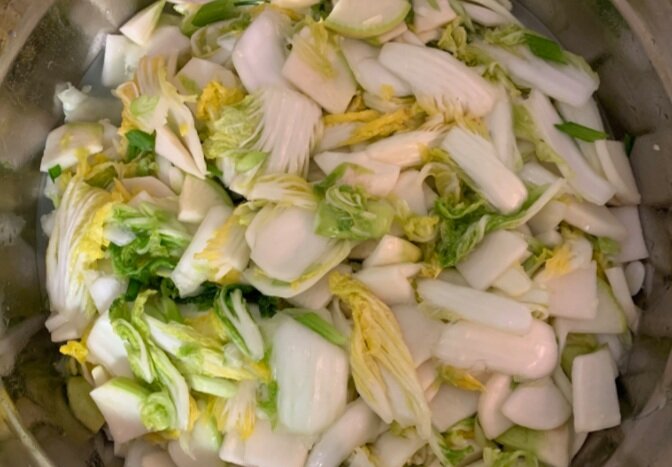Everyday White Kimchi / 손쉽고 맛있는 백김치, Los Angeles, June, 2020
내가 가장 사랑하는 사람들에게 딱 한 가지 선물을 줄 수 있다면 나는 아마 이 ‘백김치 담는 방법’ 을 택할 것이다.
김치는 이제 세계인의 음식이 되었고 김치의 종류가 많다는 것도 웬만큼 한국 음식에 관심이 있는 외국인이라면 대여섯 가지 정도는 줄줄 댈 수 있게 되었다. 몇 가지 김치를 소개하기에 앞서 이 글에서는 먼저 내가 개인적으로 제일 좋아하는 김치를 소개하려 한다.
늘 해오던 일인데 술 빚기를 하면서 김치 맛이 특히 더 좋아진 것은 아마도 발효 과정에 대한 이해가 깊어진 덕분이다. 김치를 담글 때 간혹 찹쌀죽을 넣기도 하는데 술을 담아본 사람들이라면 이 죽이 김치의 맛을 내는 데 얼마나 중요한 역할을 하는 지 느낄 수 있을 것이다. 다시 말해 죽은 김치의 감칠맛과 시원한 맛을 내는데 도움을 준다.
지금 소개할 백김치는 한국 음식이지만 세계 어느 식탁에 내놓아도 어울릴 법 하다. 동남아나 인도의 음식은 물론이고 이탈리안, 프렌치, 심지어 햄버거 곁에 두어도 환영을 받을 만하다. 그 이유를 들자면 주된 재료는 세계 어디서든 구할 수 있는 배추, 무, 소금 뿐인데다, 무엇보다도 빠뜨릴 수 없는 점 하나는 고마운 미생물들이 만들어내는 감칠맛 나는 국물 때문이다.
If I could give only one gift to the people I love the most, I would choose this recipe for classic White Kimchi.
Kimchi is now widely recognized and beloved world-wide. Non-Koreans with a keen interest in Korean cuisine might even name 5-6 different kinds of kimchi without hesitation. I will continue to introduce a few different types of kimchi on this site, but I will start with my personal favorite.
Lessons for forming suul have definitely brought a positive influence to my kimchi, largely because of my increased interest and understanding in fermentation, and the commonalities between the two processes. Most kimchi are put together with a light porridge, much like the mitsuul process, and seeing the extended effect of mitsuul in forming suul clarified the significance of adding rice porridge to promote and support fermentation in kimchi, as well.
This Korean dish would fit in beautifully amongst the wide realm of global cuisine: Southeast Asian foods would welcome its presence as a bright palette cleanser accompanying rich, spice-filled curries; Italian, French, and other European cuisines could enjoy it as a refreshing salad before a hearty meal, with a curiously attractive taste. Its broad applicability is mainly due to the simple ingredients that this dish is composed of: Cabbage, turnip, salt, and the virtuous microbes, born through fermentation, that produce the unforgettable, savory, perfectly-briny taste that is characteristic of kimchi.
재료 / Ingredients
배추 2단 / 2 bunches Napa cabbage
무 1개 / 1 turnip
굵은 소금 3/4컵 / 3/4 cup coarse sea salt
찹쌀가루 2큰술 / 2 Tbsp sweet rice flour
물 2컵 / 2 cups water
마늘 3-4쪽 / 3-4 cloves garlic
쪽파 1단 / 1 bunch spring onion
생강 작은 1쪽 / 1 small piece ginger
조리법 / Recipe
배추와 무를 흐르는 물에 깨끗이 씻어 물기를 제거한 후 먹기 좋게 자른다.
Wash cabbage and turnip clean in the running water. Drain and cut into bite-size pieces.배추와 무에 굵은 소금을 골고루 뿌린 후 잘 섞는다. 2시간 가량 절일 동안 30분에 한 번 씩 뒤적여 준다.
Generously rub coarse salt all over the cabbage and turnip pieces. Salt for 2 hours, turning every 30 min. The mixture will visibly decrease in volume.찹쌀가루 2 큰술을 물 2컵과 잘 섞어 윤기나게 죽을 쑨다.
Make porridge by combining 2 Tbsp of sweet rice flour with 2 cups of water. Bring to a boil, and simmer until thick.마늘과 생강은 잘게 썰고 파는 어슷 썰어 식힌 죽과 잘 버무린다.
Finely chop garlic and ginger, and slice the spring onions into 1-inch pieces. Add to the cooled porridge and mix well.소금에 절인 배추와 무에 물 3리터를 붓고 섞어 헹군 후 소금물 2리터를 쏟아 버린다
Pour 3 liter of cold water over the salted cabbage and turnip. Wash briefly and pour out 2 liters of water.팁: 맛을 보아 짜면 맹물을 조금 더 부어 희석시키고 싱거우면 소금을 조금 더 넣어 섞는다.
Tip: If the mixture is too salty, add fresh water. If bland, add more salt.죽/양념 혼합을 5.의 배추/무가 담긴 자배기에 부어 골고루 잘 섞는다.
Pour the porridge mixture into the cabbage/turnip bowl, and mix well.위를 덮고 하루 이틀 동안 상온에서 익힌 후 냉장고에 보관한다.
Cover and leave at room temperature for a day, or until the kimchi begins to smell good, like pickled vegetables. Place in an airtight jar or container and refrigerate.

